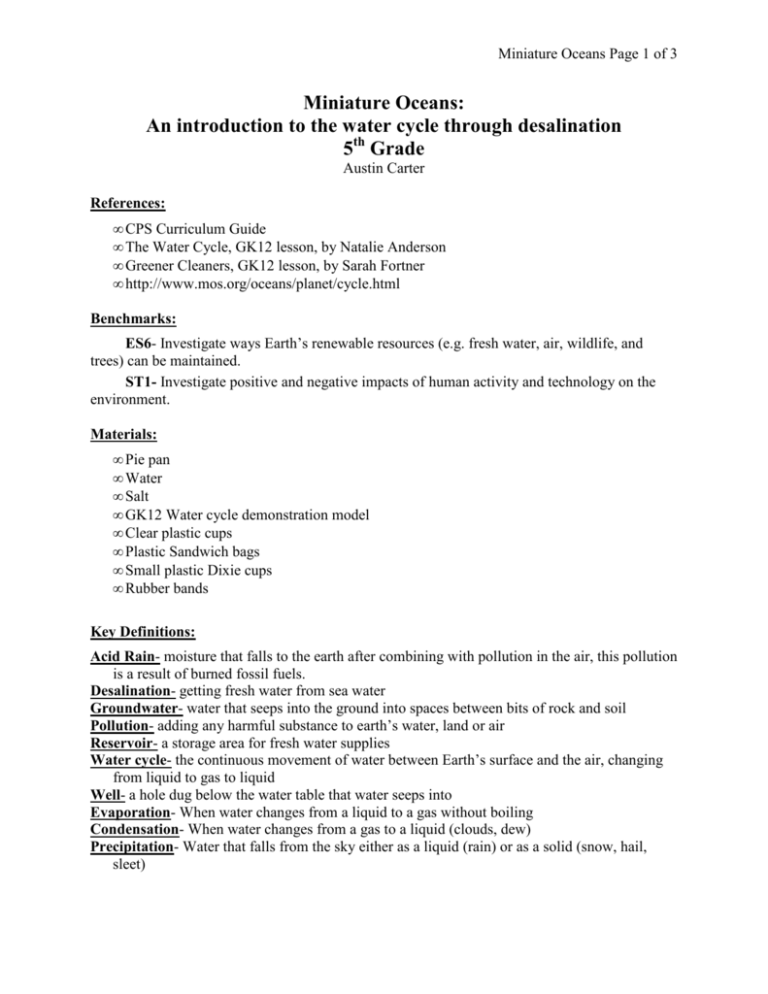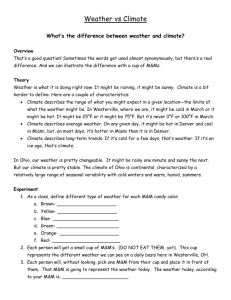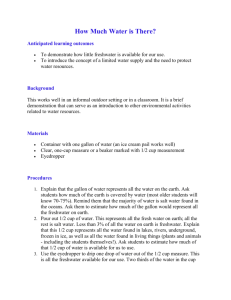Miniature Oceans - Home | gk-12
advertisement

Miniature Oceans Page 1 of 3 Miniature Oceans: An introduction to the water cycle through desalination 5th Grade Austin Carter References: • • • • CPS Curriculum Guide The Water Cycle, GK12 lesson, by Natalie Anderson Greener Cleaners, GK12 lesson, by Sarah Fortner http://www.mos.org/oceans/planet/cycle.html Benchmarks: ES6- Investigate ways Earth’s renewable resources (e.g. fresh water, air, wildlife, and trees) can be maintained. ST1- Investigate positive and negative impacts of human activity and technology on the environment. Materials: • • • • • • • • Pie pan Water Salt GK12 Water cycle demonstration model Clear plastic cups Plastic Sandwich bags Small plastic Dixie cups Rubber bands Key Definitions: Acid Rain- moisture that falls to the earth after combining with pollution in the air, this pollution is a result of burned fossil fuels. Desalination- getting fresh water from sea water Groundwater- water that seeps into the ground into spaces between bits of rock and soil Pollution- adding any harmful substance to earth’s water, land or air Reservoir- a storage area for fresh water supplies Water cycle- the continuous movement of water between Earth’s surface and the air, changing from liquid to gas to liquid Well- a hole dug below the water table that water seeps into Evaporation- When water changes from a liquid to a gas without boiling Condensation- When water changes from a gas to a liquid (clouds, dew) Precipitation- Water that falls from the sky either as a liquid (rain) or as a solid (snow, hail, sleet) Miniature Oceans Page 2 of 3 Target Concept: Students should become familiar with the water cycle and the terms evaporation, condensation, and precipitation. Students should identify that water is a renewable resource. Students should recognize how pollution affects the water cycle. For instance pollution upstream gets taken to the oceans by rivers and groundwater; air pollution joins with rain and can form acid rain. Initial Demonstration: Dissolve an unspecified quantity of salt into warm water. Explain that you are making saltwater. Where on Earth do we find saltwater? [Oceans] Pour a small amount of the solution into the bottom of a pie pan and set by a sunny window. Ask the students to make a prediction about what will happen to the saltwater after a few days. [The water will evaporate the salt will not. After a few days the pie pan will have just salt in the bottom of it.] Initial Discussion: Begin to discuss the water cycle. Begin by talking about what evaporation is and how water from the ocean and from lakes and rivers evaporates. Next talk about how water vapor (gas) condenses when it gets cold high in the atmosphere. Condensation is like the water droplets on the outside of a cold pop can; the water vapor in the air cools and condenses around the cold pop can. Explain that clouds are water vapor that is condensing. Next explain that when the water condenses enough, liquid falls out of the sky as precipitation. This can be in the form of rain, snow, sleet, and hail. Once on the ground the water then flows in rivers and underground to lakes and oceans. It’s a cycle! Demonstrate how this works using the GK12 water cycle demonstration. Procedure: 1) Explain that we are going to make miniature water cycles of our own. Give them a clear cup, a small plastic Dixie cup, a plastic sandwich bag, and a rubber band. Actually, you Miniature Oceans Page 3 of 3 might want to hold off on giving them the rubber band until later. 2) Have the students label their Dixie cup “ocean” and write their name on the side of the large cup. 3) Have the students add one tablespoon of salt to their Dixie cup and partially fill the rest with warm water. Have the students stir the solution with their pinky until the salt is dissolved. 4) Have the students taste the water with their pinky and write down their observation. 5) Have the students place their miniature ocean in the larger cup. Use the plastic sandwich bag to cover the cup and rubber band it tight over the top. The plastic bag may need to be cut to pull flat over the top of the cup. 6) Have the students set their cups in the window sill (hopefully in the sun) and ask them to make predictions using words and/or diagrams. a. What will happen to the water? b. What will happen to the salt? Extension & Discussion: Does the water have anywhere to go? [No] The amount of water on Earth does not change over time either; it just cycles from one part of Earth to another. Why is the water cycle important to life on Earth? How does pollution affect the water cycle? Consider solid/liquid pollution (toxins seep into the groundwater and get taken to rivers, lakes and oceans) as well as air pollution (chemicals mix with rain to form acid rain). Demonstrate that acid rain is harmful. Take some vinegar (weak acid) and put a few pieces of chalk or limestone into it and observe what happens. Follow Up: A few days later, come back to the experiment. Look at the pie pan that was set by the window. Is there any water left in it? Is there any salt in the pan? Now look at the student’s miniature ocean experiment. At this point most of the water in the small cup should have evaporated and condensed along the side of the cup. Some of the water may drip down to the bottom of the large cup. Taste the water outside of the small cup but inside the large cup. Have them record their observations. This should be fresh water since the salt is unable to evaporate. Label the different stages of the water cycle on the cup: evaporation, condensation, and precipitation.






